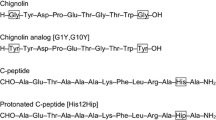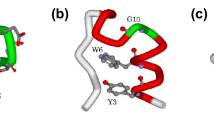Abstract
Elucidating the relationship between sequence and conformation is essential for the understanding of functions of proteins. While sharing 88 % sequence identity and differing by only seven residues, GA88 and GB88 have completely different structures and serve as ideal systems for investigating the relationship between sequence and function. Benefiting from the continuous advancement of the computational ability of modern computers, molecular dynamics (MD) simulation is now playing an increasingly important role in the study of proteins. However, the reliability of MD simulations is limited by the accuracy of the force fields and solvent model approximations. In this work, several AMBER force fields (AMBER03, AMBER99SB, AMBER12SB, AMBER14SB, AMBER96) and solvent models (TIP3P, IGB5, IGB7, IGB8) have been employed in the simulations of GA88 and GB88. The statistical results from 19 simulations show that GA88 and GB88 both adopt more compact structures than the native structures. GB88 is more stable than GA88 regardless of the force fields and solvent models utilized. Most of the simulations overestimated the salt bridge interaction. The combination of AMBER14SB force field and IGB8 solvent model shows the best overall performance in the simulations of both GA88 and GB88. AMBER03 and AMBER12SB also yield reasonable results but only in the TIP3P explicit solvent model.








Similar content being viewed by others
References
Anfinsen C (1973) Principles that govern the folding of protein chains. Science 181:223–230
Araki M, Tamura A (2007) Transformation of an α-helix peptide into a β-hairpin induced by addition of a fragment results in creation of a coexisting state. Proteins 66:860–868
Murzin A, Brenner S, Hubbard T, Chothia C (1995) SCOP a structural classification of proteins database for the investigation of sequences and structures. J Mol Biol 247:536–540
Orengo C, Michie A, Jones D, Swindells M, Thornton J (1997) CATH—a hierarchic classification of protein domain structures. Structure 5:1093–1109
Rose G, Creamer T (1994) Protein folding: predicting predicting. Proteins 19:1–3. http://www.ncbi.nlm.nih.gov/pubmed/?term=Protein+folding%3A+predicting+predicting+creamer
Jones D, Moody C, Uppenbrink J, Viles J, Doyle P, Harris C, Pearl L, Sadler P, Thornton J (1996) Towards meeting the paracelsus challenge: the design, synthesis, and characterization of paracelsin-43, an alpha-helical protein with over 50 % sequence identity to an all-beta protein. Proteins 24:502–513
Rose G (1997) The Paracelsus Challenge. Nat Protein Folding Struct Biol 4:512–514
Dalal S, Balasubramanian S, Regan L (1997) Protein alchemy: changing beta-sheet into alpha-helix. Nat Struct Biol 4:548–552
Yuan S, Clarke N (1998) A hybrid sequence approach to the paracelsus challenge. Proteins 30:136–143
Alexander P, He Y, Chen Y, Orban J, Bryan P (2007) The design and characterization of two proteins with 88 sequence identity but different structure and function. Proc Natl Acad Sci 104:11963–11968
Alexander P, He Y, Chen Y, Orban J, Bryan P (2009) A minimal sequence code for switching protein structure and function. Proc Natl Acad Sci 106:21149–21154
He Y, Chen Y, Alexander P, Bryan P, Orban J (2008) NMR structures of two designed proteins with high sequence identity but different fold and function. Proc Natl Acad Sci 105:14412–14417
Cordes M, Burton R, Walsh N, McKnight C, Sauer R (2000) An evolutionary bridge to a new protein fold. Nat Struct Biol 7:1129–1132
Van Dorn L, Newlove T, Chang S, Ingram W, Cordes M (2006) Relationship between sequence determinants of stability for two natural homologous proteins with different folds. Biochemistry 45:10542–10553
Meier S, Jensen P, David C, Chapman J, Holstein T, Grzesiek S, Ozbek S (2007) Continuous molecular evolution of protein-domain structures by single amino acid changes. Curr Biol 17:173–178
Kister A, Phillips J (2008) Stringent test for hydrophobicity scales: Two proteins with 88 % sequence identity but different structure and function. Proc Natl Acad Sci 105:9233–9237
He Y, Chen Y, Alexander P, Bryan P, Orban J (2012) Mutational tipping points for switching protein folds and functions. Structure 20:283–291
Shen Y, Bryan P, He Y, Orban J, Baker D, Bax A (2010) De novo structure generation using chemical shifts for proteins with high-sequence identity but different folds. Protein Sci 19:349– 356
Giri R, Morrone A, Travaglini-Allocatelli C, Jemth P, Brunori M, Gianni S (2012) Folding pathways of proteins with increasing degree of sequence identities but different structure and function. Proc Natl Acad Sci 109:17772–17776
Kouza M, Hansmann U (2012) Folding simulations of the a and b domains of protein. G J Phys Chem B 116:6645–6653
Lazim R, Mei Y, Zhang D (2012) Replica exchange molecular dynamics simulation of structure variation from α/4 β-fold to 3 α-fold protein. J Mol Model 18:1087–1095
Wu X, Jin Z, Xiu Z, Li G (2013) The challenge to the rule of homology modeling: folding mechanism study of protein GA and GB with high sequence identity but different native structures. Curr Pharm Design 19:2282–2292
Onuchic J, Luthey-Schulten Z, Wolynes P (1997) Theory of protein folding: the energy landscape perspective. Annu Rev Phys Chem 48:545–600
Cheung M, Chavez L, Onuchic J (2004) The energy landscape for protein folding and possible connections to function. Polymer 45:547–555
Jorgensen W (2004) The many roles of computation in drug discovery. Science 303:1813–1818
Jones DT (1999) Protein Secondary structure prediction based on position-specific scoring matrices. J Mol Biol 292:195–202
Zhang Y (2008) I-TASSER server for protein 3D structure prediction. BMC Bioinforma 9:40
Soding J (2005) Protein homology detection by HMM-HMM comparison. Bioinformatics 21:951–960
Jiang F, Wu Y (2014) Folding of fourteen small proteins with a residue-specific force field and replica-exchange molecular dynamics. J Am Chem Soc 136:9536–9539
Zhou R (2003) Trp-cage folding free energy landscape in explicit water. Proc Natl Acad Sci 100:13280–13285
Lei HX, Wu CH, Liu HG, Duan Y (2007) Folding free-energy landscape of villin headpiece subdomain from molecular dynamics simulations. Proc Natl Acad Sci 104:4925–4930
Lindorff-Larsen K, Piana S, Dror RO, Shaw DE (2011) How fast-folding proteins fold. Science 334:517–520
Mei Y, Wei C, Yip YM, Ho CY, Zhang JZH, Zhang D (2012) Thermodynamic studies of trp-cage based on polarized force field. Theor Chem Folding Acc 131:1168
Gao Y, Lu X, Duan L, Zhang D, Mei Y, Zhang JZH (2013) Direct folding simulation of a long helix in explicit water. Appl Phys Lett 102:193706
Duan LL, Gao Y, Mei Y, Zhang QG, Tang B, Zhang JZH (2012) Folding of a helix is critically stabilized by polarization of backbone hydrogen bonds: Study in explicit water. J Phys Chem B 116:3430–3435
Xiang Y, Duan LL, Zhang JZH (2010) Folding dynamics of a small protein at room temperature via simulated coherent two-dimensional infrared spectroscopy. Phys Chem Chem Phys 12:15681–15688
Duan LL, Mei Y, Zhang DW, Zhang QG, Zhang JZH (2010) Folding of a helix at room temperature is critically aided by electrostatic polarization of intraprotein hydrogen bonds. J Am Chem Soc 132:11159–11164
Nguyen H, Maier J, Huang H, Perrone V, Simmerling C (2014) Folding simulations for proteins with diverse topologies are accessible in days with a physics-based force field and implicit solvent. J Am Chem Soc 136:13959–13962
Zeng J, Jiang F, Wu Y (2016) Folding simulations of an α-helical hairpin motif α t α with residue-specific force fields. J Phys Chem B 120:33–41
Lopes PE, Guvench O, MacKerell AJ (2015) Current status of protein force fields for molecular dynamics simulations. Methods Mol Biol 1215:47–71
Luchko T, Gusarov S, Roe DR, Simmerling C, Case DA, Tuszynski J, Kovalenko A (2010) Three-dimensional molecular theory of solvation coupled with molecular dynamics in amber. J Chem Theory Comput 6:607–624
Best R, Buchete N, Hummer G (2008) Are current molecular dynamics force fields too helical?. Biophys J 95:L07–L09
Rubinstein A, Sherman S (2004) Influence of the solvent structure on the electrostatic interactions in proteins. Biophys J 87:1544–1557
Affleck R, Haynes C, Clark D (1992) Solvent dielectric effects on protein dynamics. Proc Natl Acad Sci 89:5167–5170
Pitera J, Falta M, van Gunsteren W (2001) Dielectric properties of proteins from simulation: the effects of solvent, ligands, pH, and temperature. Biophys J 80:2546–2555
Chopra G, Summa C, Levitt M (2008) Solvent dramatically affects protein structure refinement. Proc Natl Acad Sci 105:20239–20244
Chen J, Brooks CI (2007) Can molecular dynamics simulations provide high-resolution refinement of protein structure. Proteins 67:922–930
Xia B, Tsui V, Case D, Dyson H, Wright P (2002) Comparison of protein solution structures refined by molecular dynamics simulation in vacuum, with a generalized Born model, and with explicit water. J Biomol NMR 22:317–331
Im W, Chen J, Brooks CI (2005) Peptide and protein folding and conformational equilibria: theoretical treatment of electrostatics and hydrogen bonding with implicit solvent models. Adv Protein Chem 72:173–193
Bursulaya B, Brooks CR (2000) Comparative study of the folding free energy landscape of a three-stranded β-sheet protein with explicit and implicit solvent models. J Phys Chem B 104:12378–12383
Feig M Modeling solvent environments: applications to simulations of biomolecules. 2010, Book
Duan Y, Wu C, Chowdhury S, Lee M, Xiong G, Zhang W, Yang R, Cieplak P, Luo R, Lee T et al (2003) A Point-charge force field for molecular mechanics simulations of proteins based on condensed-phase quantum mechanical calculations. J Comput Chem 24:1999–2012
Hornak V, Abel R, Okur A, Strockbine B, Roitberg A, Simmerling C (2006) Comparison of multiple amber force fields and development of improved protein backbone parameters. Proteins 65:712–725
Kollman P, Dixon R, Cornell W, Fox T, Chipot C, Pohorille A (1997). In: van Gunsteren W, Weiner P, Wilkinson A (eds) Computer Simulation of Biomolecular Systems, vol 3. Springer, Netherlands, pp 83–96
Onufriev A, Bashford D, Case D (2004) Exploring protein native states and large-scale conformational changes with a modified generalized Born model. Proteins 55:383–394
Mongan J, Simmerling C, McCammon J, Case D, Onufriev A (2007) Generalized born model with a simple, robust molecular volume correction. J Chem Theory Comput 3:156– 169
Nguyen H, Roe DR, Simmerling C (2013) Improved generalized born solvent model parameters for protein simulations. J Chem Theory Comput 9:2020–2034
Jorgensen W, Chandrasekhar J, Madura J, Impey R, Klein M (1983) Comparison of simple potential functions for simulating liquid water. J Chem Phys 79:926–935
Debye P (1909) Naherungsformeln fur die Zylinderfunktionen fur grobe Werte des Arguments und unbeschrankt veranderliche Werte des Index. Math Ann 67:535–558
Morales J, Nocedal J (2000) Automatic preconditioning by limited memory quasi-Newton updating. SIAM J Optim 10:1079– 1096
Pastor R, Brooks B, Szabo A (1988) An analysis of the accuracy of Langevin and molecular dynamics algorithms. Mol Phys 65:1409–1419
Ryckaert J, Ciccotti G, Berendsen H (1977) Numerical integration of the Cartesian equations of motion of a system with constraints: molecular dynamics of n-alkanes. J Comput Phys 23:327– 341
Darden T, York D, Pedersen L (1993) Particle mesh Ewald: An N l o g(N) method for Ewald sums in large systems. J Chem Phys 98:10089–10092
Case DA, Darden TA, Cheatham IIIT. E, Simmerling CL, Wang J, Duke RE, Luo R, Walker RC, Zhang W, Merz KM et al (2010) AMBER 11. University of California, San Francisco
Shell M, Ritterson R, Dill K (2008) Test on peptide stability of AMBER force fields with implicit solvation. J Phys Chem B 112:6878–6886
Acknowledgments
The authors thank the Supercomputer Center of East China Normal University for the support of CPU time.
Author information
Authors and Affiliations
Corresponding author
Electronic supplementary material
Below is the link to the electronic supplementary material.
Rights and permissions
About this article
Cite this article
Zeng, J., Li, Y., Zhang, J.Z. et al. Examination of the quality of various force fields and solvation models for the equilibrium simulations of GA88 and GB88. J Mol Model 22, 177 (2016). https://doi.org/10.1007/s00894-016-3027-8
Received:
Accepted:
Published:
DOI: https://doi.org/10.1007/s00894-016-3027-8




